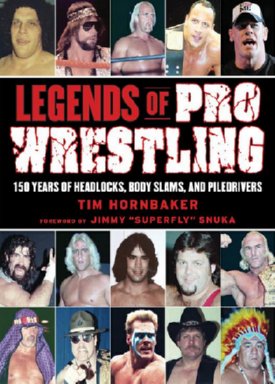Author Tim Hornbaker’s second book, Legends of Pro Wrestling: 150 Years of Headlocks, Body Slams, and Piledrivers, has just come out, and he took the time to explain who made the cut in the expansive list of wrestling greats, how he did some of his research, and what some of his ideas for future books might be.

SLAM! Wrestling: Could you describe how you started out in his selection process? Who did you consult, if anyone?
Tim Hornbaker: This is a book I wanted to do for a long time, and had created a basic list of 400 wrestlers probably 10 years ago who I wanted to include if I ever got the opportunity to write it. Once the actual book went into motion, and I discussed the possibility of featuring 500 wrestlers with the publisher, I went back to the drawing board and began adding names off the top of my head. It wasn’t until I began researching and writing the book that I slowly refined the names, adding people who I thought had achieved legendary status and others who had contributed great things to the sport’s history. From time-to-time, I did communicate with fellow researchers, but I had the tough, but fun job of finalizing the list of the wrestlers to include.
SLAM! Wrestling: Did you begin with a number of wrestlers you wanted in the book, or for each era?
Hornbaker: When I initially sat down to write the book, I had the daunting task of writing profiles for 500 professional wrestling legends. Because I knew that the list was going to change as I went forward, it was difficult to say at the time how many wrestlers would represent each particular era. The “Pioneers” section finished with 53 wrestlers, but may have been 40 names when I started. Everything kind of evolved naturally as I went along, but there were some obstacles that prevented some of the great wrestlers I wanted to include, from making the final list.
SLAM! Wrestling: Do you remember the last person you cut from the list?
Hornbaker: Of course, and it still sticks in my craw. Charles Olson was a legendary catch-as-catch-can grappler in the early part of the 20th century. He was a wrestling specialist and barnstormer, a guy who is needed in a book of this kind. But the problem was that I couldn’t find a good photo of him, and it was set in stone that we wanted to include an image with every profile. So he was axed probably weeks before the text was finalized. Tom Connors was probably the second-to-last cut from the list, and he too was a famous catch superstar in the late 1800s. This time I had a photo, but just couldn’t pull enough solid facts together for his profile, and just ran out of time.
SLAM! Wrestling: Was there ever a consideration of making this an on-line resource that could be updated, or do you in fact plan to publish an updated list in the future?
Hornbaker: This was always a book idea, something that even predated my NWA project. I envisioned fans of all ages having the ability to read about the great superstars who’ve entertained millions with their striking athleticism, some they may know, others they are learning about for the first time. A book featuring facts and insight into such a wide spectrum of wrestlers, from Frank Gotch to John Cena, can be a valuable reference tool, and a nice companion for current WWE and TNA wrestling. I think it would be a great idea to update it sometime in the future, and I would be happy to do it.
SLAM! Wrestling: What about managers, referees, announcers … could they warrant a book of their own?
Hornbaker: Definitely. I think the preservation of wrestling history is crucially important. Anything that can be created to document the facts and stories of any of these individuals is coveted at this point. If historians and researchers don’t take these steps now, much of his history will be forever lost — and left to the slant of a particular promotion, which, as we know, can be completely revisionist history.
SLAM! Wrestling: Was the lead in the SLAM! Wrestling review — Legends of Pro Wrestling an informative resource — accurate? Was it difficult to pin down the truth about early wrestlers based on conflicting promotional material?
Hornbaker: The mysterious nature of pro wrestling has always been a challenge for historians. Peeling back the protective surface of wrestling is no easy task, especially when you start looking for legitimate dates of birth, real names, etc. Not every piece of information is available on the Internet, and a ton of facts had to be dug up, clarified, corrected, and placed into the proper context. The chore of deciphering pro wrestling history can be a lifetime task, and for the people who love to do it, it can be very rewarding.
SLAM! Wrestling: What was the greatest resource in working on this book, compared to the NWA book?
Hornbaker: It may be surprising, but I spent a lot of time utilizing genealogical databases and sources, which served to assist in locating certain dates, family lineages, and other facts necessary for each profile. Having the ability to locate and double-check dates was crucial, and I found a lot of interesting tidbits of information on the biggest names in wrestling history.
SLAM! Wrestling: Is it fair to say that this book will be a lot more accessible to the average fan than the NWA book?
Hornbaker: I think Legends of Pro Wrestling is the kind of book that anyone interested in professional wrestling can enjoy. It can be a fun read for casual fans, utilized by journalists and historians for quick reference, and may even inspire someone to take an interest in studying wrestling history. I hope people will pick this book up and have great memories of some of the wrestlers they may have seen years earlier, and, at the same time, receive an education about the other superstars who paved the way.
SLAM! Wrestling: What’s the next project?
Hornbaker: As of today, there are a few potential projects, and one in particular I’m enthusiastic about, but nothing is guaranteed as of yet. I would maybe be interested in doing an NWA-type book on the AWA, or even the WWE for that matter, but many factors would have to fall into place for that to happen. One day, perhaps we’ll revise the NWA book. But my next project may be on another sport altogether.
SLAM! Wrestling: What would a dream project be?
Hornbaker: I would love to find an interesting person from history, wrestling or otherwise, who hasn’t already been written about in detail — and give them the full treatment. I mean a complete biographical effort, from beginning to end, and really search under every rock for details of their life. A David McCullough kind of effort, of course, with his benchmark being the level of quality and thoroughness all researchers want to achieve.
SLAM! Wrestling: How did the foreword from Jimmy “Superfly” Snuka come about?
Hornbaker: We wanted to find a recognizable wrestling legend who every fan could identify, and the great “Superfly” lived up to that standard. Snuka has provided people with so many memories over his outstanding career and is a true Hall of Famer, so he was a terrific fit for this book.
— questions by Dave Hillhouse and Greg Oliver
RELATED LINKS

